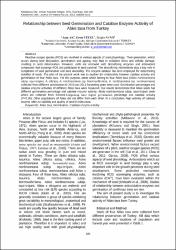Relationship between Seed Germination and Catalase Enzyme Activity of Abies taxa from Turkey
Özet
Reactive oxygen species (ROS) are involved in various aspects of seed physiology. Their generation, which occurs during seed desiccation, germination and ageing, may lead to oxidative stress and cellular damage, resulting in seed deterioration. However, cells are endowed with detoxifying enzymes and antioxidant compounds that scavenge ROS and participate in seed survival. The detoxifying mechanisms play a key role in completion of seed germination and seed storability. The enzyme catalase has been employed for determining viability of seeds. The plan of the present work was to explore the relationship between catalase activity and germination of four Abies taxa. For this purpose, seeds which belong to four Abies taxa (Abies nordmanniana subsp. equi-troj ani, A. cilicica, A. nordmanniana ssp. bornmuelleriana, A. nordmanniana ssp. nordmanniana) collected from different provenances in 2010 and 2011 harvesting years were used. Germination percentages and catalase enzyme activities of different Abies taxa were measured. Our results demonstrate that Abies seeds had different germination percentage and catalase enzyme activity. Abies nordmanniana subsp. equi-troj ani seeds which are collected from Edremit-GÜrgendag have higher germination percentage and catalase activity (P>0.05). Other populations of Abies did not differ from each other. In a conclusion, high activity of catalase enzyme refers to viability and quality of seed in Abies taxa. Reactive oxygen species (ROS) are involved in various aspects of seed physiology. Their generation, which occurs during seed desiccation, germination and ageing, may lead to oxidative stress and cellular damage, resulting in seed deterioration. However, cells are endowed with detoxifying enzymes and antioxidant compounds that scavenge ROS and participate in seed survival. The detoxifying mechanisms play a key role in completion of seed germination and seed storability. The enzyme catalase has been employed for determining viability of seeds. The plan of the present work was to explore the relationship between catalase activity and germination of four Abies taxa. For this purpose, seeds which belong to four Abies taxa (Abies nordmanniana subsp. equi-troj ani, A. cilicica, A. nordmanniana ssp. bornmuelleriana, A. nordmanniana ssp. nordmanniana) collected from different provenances in 2010 and 2011 harvesting years were used. Germination percentages and catalase enzyme activities of different Abies taxa were measured. Our results demonstrate that Abies seeds had different germination percentage and catalase enzyme activity. Abies nordmanniana subsp. equi-troj ani seeds which are collected from Edremit-GÜrgendag have higher germination percentage and catalase activity (P>0.05). Other populations of Abies did not differ from each other. In a conclusion, high activity of catalase enzyme refers to viability and quality of seed in Abies taxa.
Kaynak
Kastamonu Üniversitesi Orman Fakültesi DergisiCilt
12Sayı
3Bağlantı
http://www.trdizin.gov.tr/publication/paper/detail/TVRnek56QTBOQT09https://hdl.handle.net/11421/15846
Koleksiyonlar
- Makale Koleksiyonu [512]
- TR-Dizin İndeksli Yayınlar Koleksiyonu [3512]


















